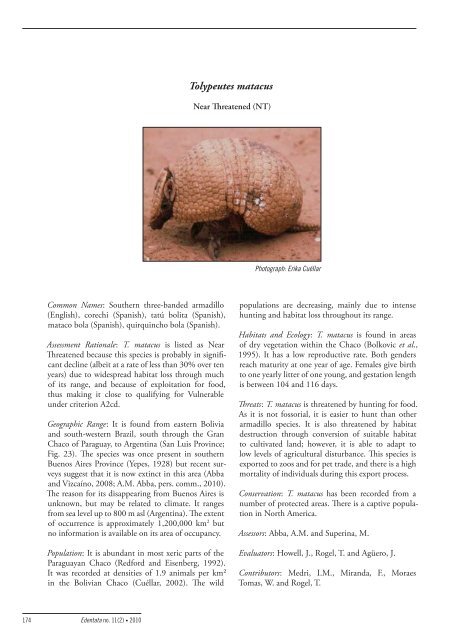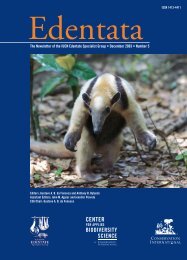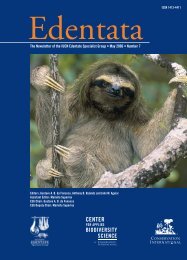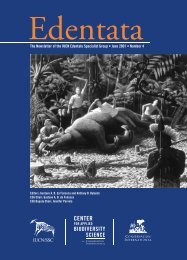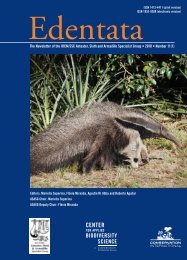Edentata 11(2), 2010 - Anteater, Sloth & Armadillo Specialist Group
Edentata 11(2), 2010 - Anteater, Sloth & Armadillo Specialist Group
Edentata 11(2), 2010 - Anteater, Sloth & Armadillo Specialist Group
- No tags were found...
You also want an ePaper? Increase the reach of your titles
YUMPU automatically turns print PDFs into web optimized ePapers that Google loves.
Tolypeutes matacusNear Threatened (NT)Photograph: Erika CuéllarCommon Names: Southern three-banded armadillo(English), corechi (Spanish), tatú bolita (Spanish),mataco bola (Spanish), quirquincho bola (Spanish).Assessment Rationale: T. matacus is listed as NearThreatened because this species is probably in significantdecline (albeit at a rate of less than 30% over tenyears) due to widespread habitat loss through muchof its range, and because of exploitation for food,thus making it close to qualifying for Vulnerableunder criterion A2cd.Geographic Range: It is found from eastern Boliviaand south-western Brazil, south through the GranChaco of Paraguay, to Argentina (San Luis Province;Fig. 23). The species was once present in southernBuenos Aires Province (Yepes, 1928) but recent surveyssuggest that it is now extinct in this area (Abbaand Vizcaíno, 2008; A.M. Abba, pers. comm., <strong>2010</strong>).The reason for its disappearing from Buenos Aires isunknown, but may be related to climate. It rangesfrom sea level up to 800 m asl (Argentina). The extentof occurrence is approximately 1,200,000 km 2 butno information is available on its area of occupancy.Population: It is abundant in most xeric parts of theParaguayan Chaco (Redford and Eisenberg, 1992).It was recorded at densities of 1.9 animals per km²in the Bolivian Chaco (Cuéllar, 2002). The wildpopulations are decreasing, mainly due to intensehunting and habitat loss throughout its range.Habitats and Ecology: T. matacus is found in areasof dry vegetation within the Chaco (Bolkovic et al.,1995). It has a low reproductive rate. Both gendersreach maturity at one year of age. Females give birthto one yearly litter of one young, and gestation lengthis between 104 and <strong>11</strong>6 days.Threats: T. matacus is threatened by hunting for food.As it is not fossorial, it is easier to hunt than otherarmadillo species. It is also threatened by habitatdestruction through conversion of suitable habitatto cultivated land; however, it is able to adapt tolow levels of agricultural disturbance. This species isexported to zoos and for pet trade, and there is a highmortality of individuals during this export process.Conservation: T. matacus has been recorded from anumber of protected areas. There is a captive populationin North America.Assessors: Abba, A.M. and Superina, M.Evaluators: Howell, J., Rogel, T. and Agüero, J.Contributors: Medri, I.M., Miranda, F., MoraesTomas, W. and Rogel, T.174<strong>Edentata</strong> no. <strong>11</strong>(2) • <strong>2010</strong>


